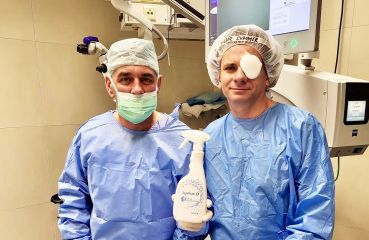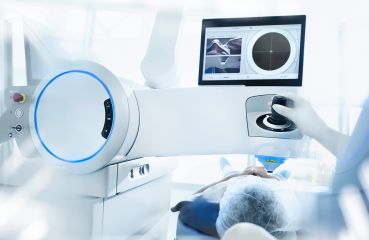How does cataract surgery take place at iClinic and when is it best to undergo it?
There are several myths about the cataract. For example, it can be treated with eye drops, or that the surgery should wait until the cataract "matures". Learn the truth and why you don’t need to be afraid of cataract surgery at iClinic.

Healthy left eye and cataract on the right eye. The gradual clouding of the lens can significantly complicate your daily life and gradually steal your sight.
Cataract is an eye disease, which annually steals the sight of many people. According to the World Health Organization it is responsible for 51% of the cases of vision loss. These unpleasant statistics are particularly affected by inadequate health care in developing countries, where only the richest have access to adequate treatment.
The situation here is, however, more favourable, because thanks to the modern treatment and experienced doctors, we managed to almost completely eliminate blindness due to non-treatment of cataract. Even our doctors at iClinic help patients to fight this disease.
And since the surgery of cataract is fully paid by health insurance, it is truly available for everyone.
When should you have cataract surgery?
If you or your loved ones have been diagnosed with cataract, you probably already know that there is no treatment that would eliminate it. Surgery is the only way. Many patients are asking whether they must undergo it immediately after diagnosis or whether they should rather wait for the cataract to fully manifest itself.
The answer is mainly up to the patient, because they should undergo surgery when the cataract prevents them from leading a normal life. This means that if they feel the unpleasant consequences such as double vision, sensitivity to light, or the gradual clouding of vision. Delaying of the surgery is not recommended in particular due to the increasing risk of complications – the more advanced the cataract, the greater the risk.
Progress of the cataract surgery – femto cataract
How does the cataract surgery take place at iClinic?
Fear of surgery is a very natural human reaction. Many of our patients feel it; however, immediately after the procedure they claim that they actually didn't have anything to worry about. Cataract surgery is the most commonly performed medical procedure in the world. Thanks to this, surgeryal techniques are constantly evolving and today they are at a top level. This is also evidenced by a gradual increase in the use of femtosecond laser.
Cataract surgery is preceded by a preoperative eye examination. After coming to our clinic, we will first check and measure your sight carefully. Only then we will be able to recommend the appropriate type of lens, which will improve your vision to the maximum. Together, we can set a date for the surgery and prescribe you eye drops that you’ll apply for three days prior to surgery.
The cataract surgery itself takes only 15-20 minutes. First we’ll numb your eye using drops, so you don’t have to worry about injections. The procedure is done under local anesthesia, general anaesthesia is used only for certain groups of patients - for example, in the case of Parkinson's disease with strong shaking.


During the surgery, you won't feel any pain and you don't have to worry about blinking - your eyelids will be held open by a speculum.
Progress of the cataract surgery – femto cataract
Using the femto laser we crush the clouded lens and thus reduce the time of an undesirable energy acting on the intraocular tissues, thereby significantly reducing the postoperative healing. Femto laser pulses create small bubbles are created in the tissue, which leads to the separation of parts of the tissue. The surgery thus enables a very accurate and gentle creation of a hole in the lens capsule (capsulotomy), and its subsequent gentle crushing (fragmentation of the lens). As the last step, the laser creates entry incisions in the cornea. The whole procedure while the laser takes only a few tens of seconds. The surgery is performed under local anaesthesia.
In recent years, the laser has become a universal instrument and symbol of precision in medicine. Cataract surgery using a femtosecond laser is, therefore, more accurate and gentle compared to the classical surgery. Sharp objects such as a scalpel, needles or scissors are not used during the surgery, and thus there is no formation of rips.
Progress of the cataract surgery – phacoemulsification
Progress of the cataract surgery – phacoemulsification
In the case of phacoemulsification, the lens core is divided into small parts and sucked out by an ultrasonically controlled cannula. This technique has the advantage of performing the entire surgery through a small incision, which reduces the amount of postoperative complications, accelerates the recovery of vision and reduces the length of the performance.
The small wound doesn’t need stitches, the eye is covered with a dressing after surgery and you can go home after about an hour. On the second day, it is necessary to come for a checkup where we remove the dressing. After the surgery, you will apply special eye drops for three to four weeks, and protect your vision with sunglasses.

What is going to happen with your vision after the surgery?
You should see the result of the surgery already on the second day. After the cataract surgery, focusing on one distance is usually fully adjusted - patients can see into the distance, but they read must wear glasses for reading. This is the case if you decide for a monofocal lens, paid by the insurance company.

If you opt for a multifocal lens, you will no longer need reading glasses.
There are also multifocal lenses that can sharpen your vision completely for both distances. These lenses, however, are covered by the patient.
Like any surgery, cataract surgery is associated with rare complications, such as bleeding or infection. The risk of complications is significantly reduced if the patient does not delay the surgery.
After the surgery, you will see how your life dramatically improves - because sight is one of the most important senses. You can do all the usual activities, but the first month after the procedure you should avoid increased physical exertion and visits to solariums, saunas or swimming pools.













